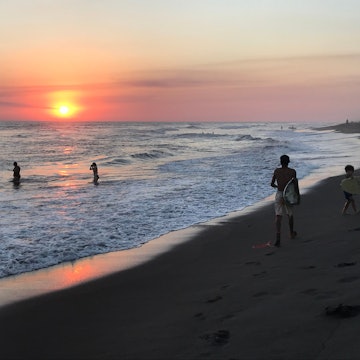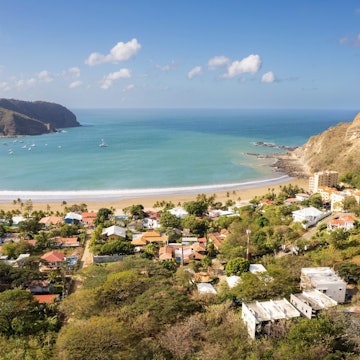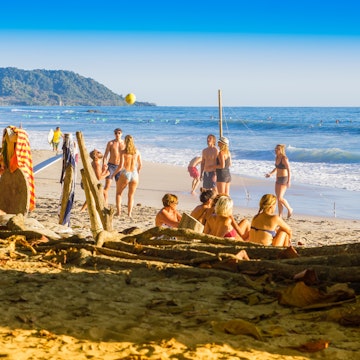
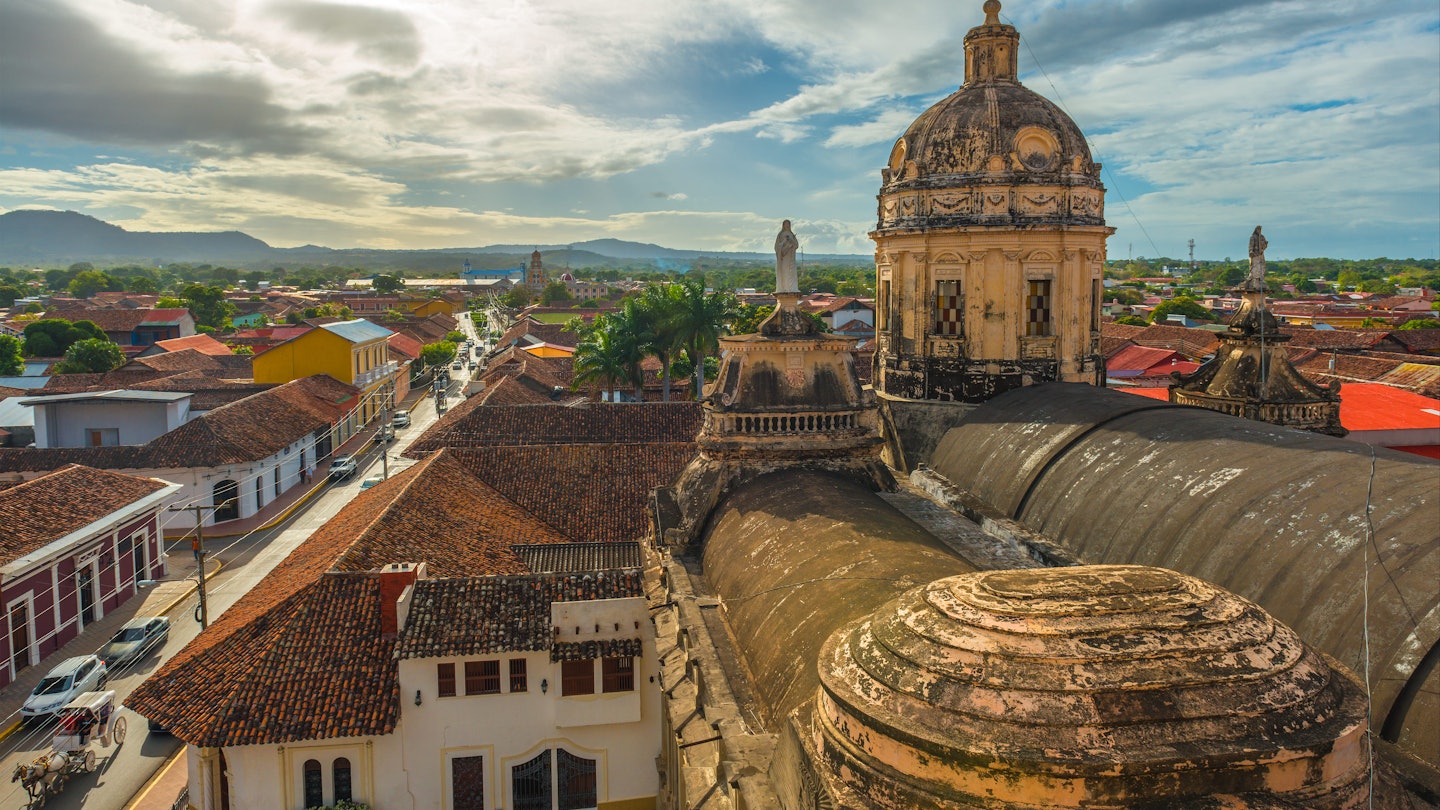
Skyline of Granada at sunset. SL_Photography/Getty Images
Granada, the former capital of Nicaragua, is a well-preserved gallery of architecture from its time as a Spanish colony, and the colorful buildings and ornate entryways just beg to be photographed from every angle. The iconic Catedral de Nuestra Señora de la Asunción rises from its center, a masterpiece of bright yellow walls and red domes. On the horizon looms Volcán Mombacho, one of the most picturesque of Nicaragua’s many volcanoes, and the waterfront abuts the storied Lago Cocibolca.
Plenty of travelers have visited Nicaragua just to wander the lively streets of this beloved city, one of the oldest former European colonies in the Americas. History buffs will find a rich Catholic heritage and endless folklore to absorb, including the city’s tragic immolation at the hands of invading Filibusteros in 1856. As well as all this, Granada remains a very real city, with 134,000 permanent residents and a proud civic culture.

1. People-watch in the Parque Central
Visitors will instantly recognize the Granada skyline from its canary-yellow church, the Catedral de Nuestra Señora de la Asunción (Our Lady of Assumption Cathedral). Few sights in Nicaragua are more iconic than the cathedral’s red-roofed domes and white trim, and tourists instantly gravitate toward this central landmark. For such a grand structure, the cathedral’s vaulted interior is fairly understated, with a few biblical frescoes and a copy of Michelangelo’s Creation of Adam on the ceiling. It’s free to enter, and regular services are held on Sundays and religious holidays. The real action takes place just outside, in the Parque Central. This vivacious square is nicely paved, shaded with trees and well trafficked by locals, and it’s surrounded on all sides by the vintage facades of high-end hotels, while numerous street vendors fry tortillas and sell fresh fruit and refreshments.
Planning tip: When night falls – and temperatures become more bearable – festive crowds converge on the Parque Central for outdoor dining and live music. The park is romantically lit every night of the year, and major festivals culminate in family-friendly concerts and fireworks just outside the cathedral. One of the biggest events is La Purísima, a 9-day festival at the start of December that celebrates the Virgin Mary with food and music.

2. Photograph a ruined hospital
One of the most haunting images in Granada is the Antiguo Hospital San Juan de Dios (Old Saint John Hospital) on the west side of town. This enormous structure, right near the bus station, stands empty and unmarked. The city of Granada is so well-preserved that it’s often jarring to see these ruins, which could easily pass for a palace or monastery. The weatherbeaten walls and collapsed ceilings suggest some terrible event, and Nicaragua is no stranger to earthquakes and fires. Yet the old hospital is actually just a victim of neglect; built in 1905, the building proved too expensive to maintain, and its upkeep changed hands for years until the expense of said upkeep finally caused it to be abandoned. Today, support beams hold up the old tower, and the rooms are thick with wild plants and peppered with debris; definitely watch your step around here.
Planning tip: The hospital is a favorite subject for photographers and ghost-hunters, and locals frequently use it as a landmark when giving directions, but the site doesn’t host any formal visits or tours.
3. Restaurant-hop through El Portal
You can’t walk past the grand entrance of El Portal food hall without a gaggle of hosts presenting menus, but this place is worth scoping out. The voluminous, open-roof complex is a popular foodie spot with several bars and restaurants inside, such as the pan-Latin diner Los Bocaditos, sports pub Beer House and pizzeria Hot Pizza Ariel. Most patrons dine at an assortment of tables on the first floor, while thirsty guests climb attractive wooden staircases to the sports bars on the second story.
El Portal is only a block west of the Parque Central, right on the busy corner of Calle El Comercio and Calle Real Xalteva. Its location is handy for backpackers staying the night nearby; there’s also a useful bike rack stationed just inside the entrance. The upper reaches are festooned with lights and leafy branches, and the echoing interior gets boisterous and boozy after dark. While the old building could pass for a repurposed train station or customs house, El Portal is just a modernized tiangue – a small market full of stalls.
Planning tip: This place is family-friendly, but be aware that cigarettes are casually tolerated.
4. Sample chocolate at two museums
Cacao trees grow best in the tropics, yet Nicaragua wasn’t known for its chocolate until the 1990s. The cacao industry has grown exponentially since then, largely in response to tourism. Today, Granada is home to two dueling chocolate museums, both of which provide a thoughtful, delicious experience.
The original pioneer is the ChocoMuseo – one of four located across Latin America – is a museum, retail store and kitchen located in a handsome old building just around the corner from the Parque Central. You can browse a panoply of chocolate products, all grown and processed in Nicaragua, or explore the displays for free. Feeling hands-on? Book online to grind your own beans and create confections at the two-hour Bean to Bar workshop.
The more recent addition is Argencove, located just 1km southwest of ChocoMuseo, near Parque Xalteva. Argencove is an artisanal chocolatier founded by three Australian families. Here visitors can purchase beautifully packaged chocolate bars with locally inspired names (Apoyo, Cocibolca) or take a 2-hour guided tour (US$5) of the facility.
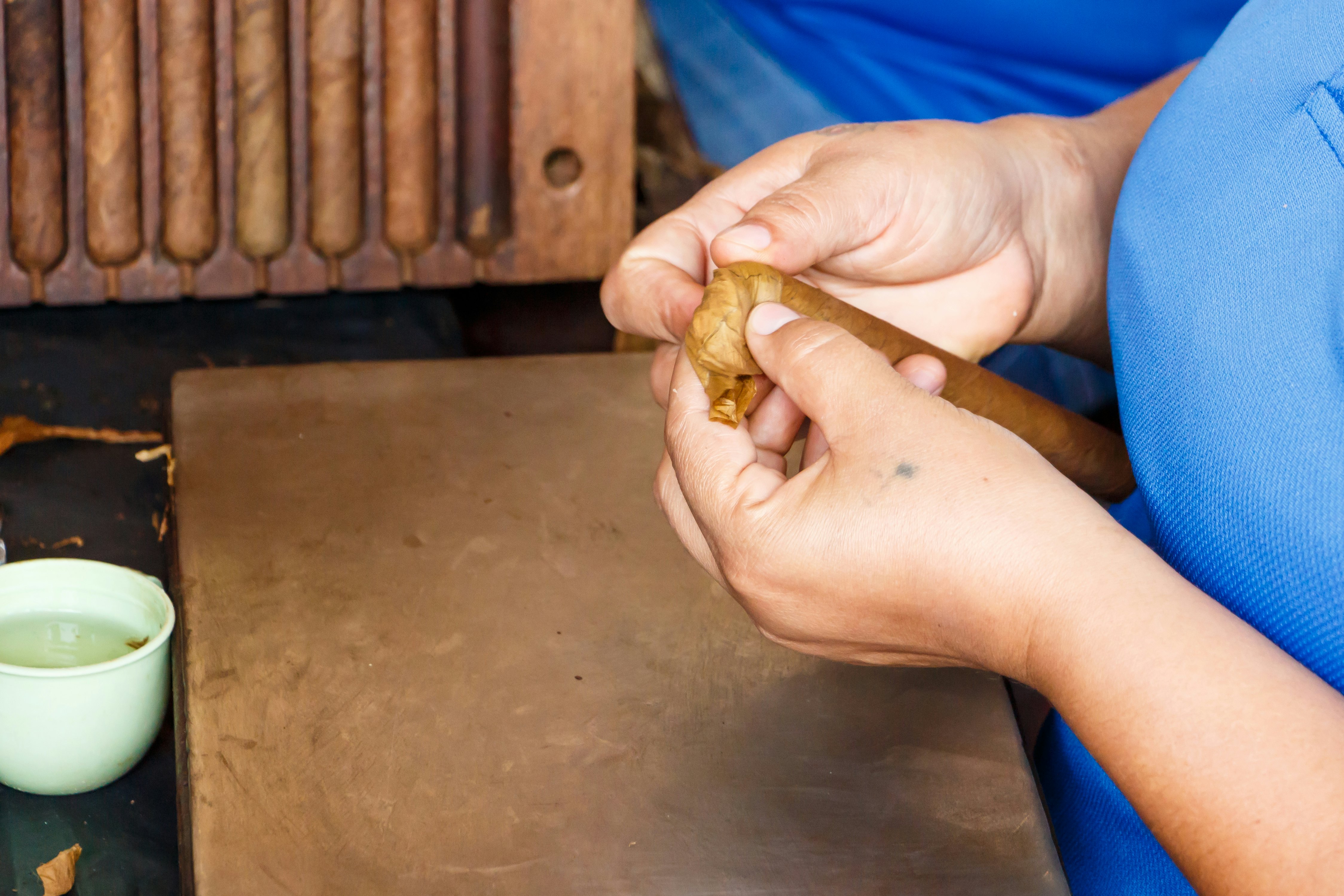
5. Watch cigar-making at Doña Elba
Tobacco is one of Nicaragua’s bigger crops, and production shifted from cigarettes to cigars in the late 1950s, largely in response to the Cuban Revolution. The Granada location of Doña Elba Cigars, a stone’s throw from Argencove, is a kind of living museum, where workers expertly roll, seal and chop the rich brown leaves by hand. Doña Elba was founded in 1996, and the company’s main factory is located hundreds of kilometers away in the highland town of Estelí, but this spacious facility in Granada is open to the public and celebrates the craft and labor that go into every stogy.
Planning tip: The factory is open daily, and walk-ins are welcome. Visitors can see the simple machinery and assembly process, then purchase boxes from the gift shop.
6. Shop Nica style on Calle El Comercio
True to its name, Calle El Comercio (Market St) is a lively outdoor marketplace jammed with stalls and vendors. The street starts about a block away from the Parque Central, and descends a gradual hill for about five blocks, terminating at a small bridge. This crowded corridor is where most residents shop for produce and specialty items; the one-way street is a frenetic traffic-jam of customers and taxis, and visitors can easily lose themselves in the maze of alleys. The wares are an eclectic mix of clothes, snacks and fresh produce, and the stalls are better for browsing than seeking a specific item. This district is a great place to practice Spanish and interact with local farmers, but it’s not for the claustrophobic – or tourists in a hurry. Most operations are open every day but Sunday.
Planning tip: If you’re renting a car, downtown Granada can be a nightmare to park in: few old buildings are equipped with garages or car ports. Instead, stay in more motor-friendly lodging in the southern or western suburbs. Two car-friendly options are the Hotel Palacio Real Granada and Hotel Casa Barcelona.

7. Make a pilgrimage to a convent
There is no greater testament to Granada’s perseverance than the Convento y Museo San Francisco (San Francisco Convent and Museum). The original convent and church were built in 1525, but were completely destroyed on several occasions thanks to the waves of 17th-century pirates and then the invasion of William Walker in 1856. After each catastrophe, the local congregation rebuilt these sacred landmarks, which alternately served as a convent and a university.
Today, the convent is a bright white structure with an impressive museum inside. The many rooms exhibit historic furnishings, spiritual relics and a sizable library. Dioramas and oil paintings illustrate everyday life in the colonial capital and its surrounding farmlands. Tile roofs slope toward a central court thick with palm trees, and a special pavilion displays millennium-old indigenous carvings. These animal-like basaltic sculptures were discovered on Isla Zapatera, a lake island about 30km south of Granada, and hint at the rich spiritual traditions of the land in the centuries before the arrival of Columbus. The biggest crowd-pleaser is the scale model of Granada that recreates every street, building and tree in town. Retrace your steps from behind the glass shield and pinpoint new parts of the city to explore.
Planning tip: The museum is open 8am to 5pm weekdays and 9am to 4pm weekends.
This article was adapted from Lonely Planet’s Central America guidebook, published in October 2025.






